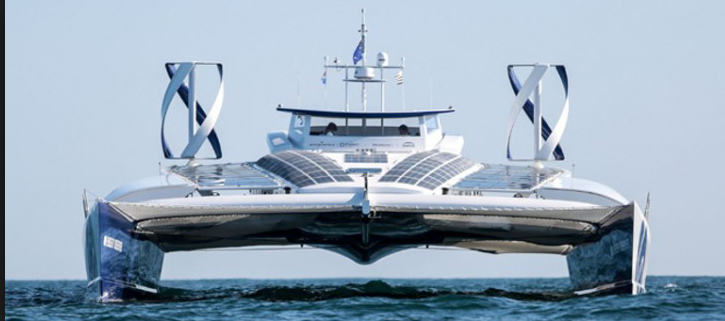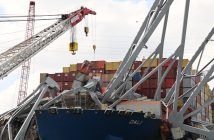Energy Observer Starts a Tour of the World, Powered by Hydrogen Produced from Seawater

By Peter A. Janssen
The first vessel in the world to produce hydrogen from seawater, Energy Observer, which looks a bit like something from outer space, just crossed from Marseille, France, to Corsica at the start of its six-year, 50-country trip around the world. It will spend this summer cruising the Med, and ultimately will make it to the Americas in 2020.
Energy Observer was launched last April in Saint-Malo, pictured above, and made the first of its planned 101 stops around the world in Paris. It then spent the summer in its own Tour of France, before stopping in Marseille for the winter. The idea is to show that an autonomous, self-sufficient vessel can travel the world indefinitely in all kinds of weather conditions, independent of fossil fuels.
The boat’s primary sources of power come from solar panels that cover 1,400 square feet, two vertical-axis wind turbines, one kite and two reversible electric motors. The electric motors can function as hydroelectric generators when the boat shifts into kite sailing mode. The hydrogen power system is the most innovative. An electrolyzer breaks down seawater into oxygen and dihydrogen, which is then stored in tanks in gas form and is used when no wind or solar is available.
Its sponsors call Energy Observer “the vessel of the future.” Its hull, however, is a remnant from the past. It was built in Canada in 1983 and was launched as a maxi multihull called Formule TAG, and it was incredibly fast. Indeed, it was the first sailboat to travel 500 miles in 24 hours. The hull now has been stretched to 100 feet; the boat has a 41-foot beam and it weighs 28 tons.
The boat’s hydrogen technology was developed over five years by more than 30 engineers and boat designers working with the French research center CEA-LITEN to prove the effectiveness of hydrogen as a renewable fuel. The many stops around the world are designed to showcase that technology, for future use on land and on sea.
The advantage of hydrogen is that it contains up to three times more energy per unit mass than diesel, and it’s the lightest and most abundant chemical in the world. Energy Observer is a zero-emission boat. Other people who have studied the possibility of a hydrogen-powered boat point out that it takes a lot of solar energy to produce hydrogen from sea water, but it can be done.
Energy Observer was designed to cruise at 8 to 10 knots. On the recent trip to Corsica, it averaged less than five knots. Captain Victorien Erussard said he was pleased with the performance, but predicted that solar energy will present a stronger part of the energy mix during the summer in the Med. Read more:




